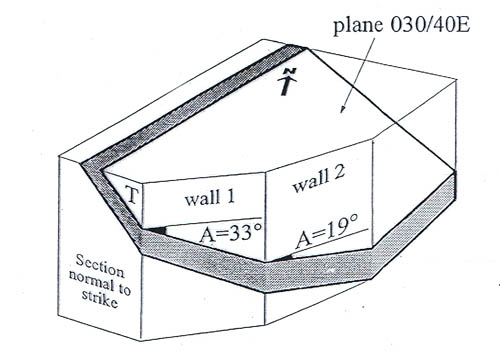
Apparent dip
On any vertical section with strike, non perpendicular to the plane, will appear to dip at a different angle, the angle of apparent dip.

Calculating the strike and the true dip form apparent dips
The problem is to finding the plane which contains two lines. The orientation of lines is known from the measured angle of apparent dip and strike of the section.
Explanation basis on an example:
Calculate the true
dip form apparent dips 48 NE and 25 SE on two vertical sections with strike
330 and 075.
Firstly, notice the lines comes from section's strike and
apparent dips 48-330 and 25-255 (The strike were changed by adding 180 degrees,
because of the dip direction). On the overlay estabilish dots which represents lines. Rotate the net until points will occur on the one great circle.
Then draw the arc along the great circle it's required plane:48/50/NW.
Calculating the apparent dip of a plane on a known plane of section
This is used in the construction of cross-section through dipping beds, faults, etc.
Explained with the aid of an example: Find apparent dip
for the plane 148/20/NE, on the vertical section 130.
Begin with drawing
a plane. Then mark the strike 130 and rotate the net until it reaches the
equator or the great circle "0". Next step is to find the the point where
the plane crosses the equator. Estabilish a dot in this place and measure
it. The angle of dip of this line is also the apparent dip and it's 6 degrees.
| Autor: Kamil Wojtanowski[Contact] |

|

